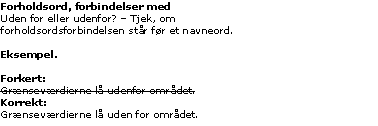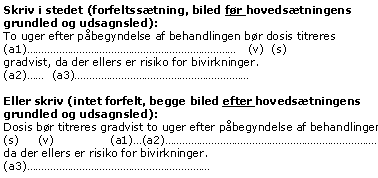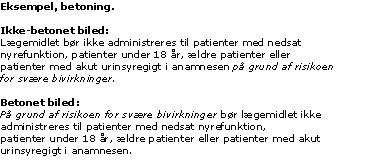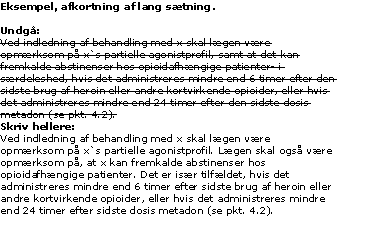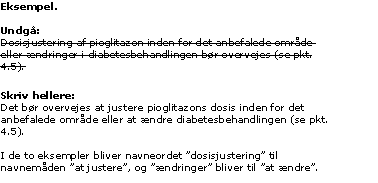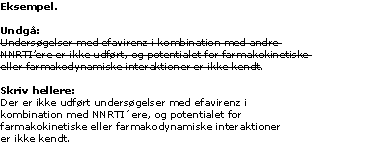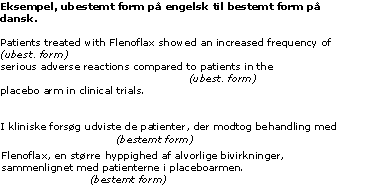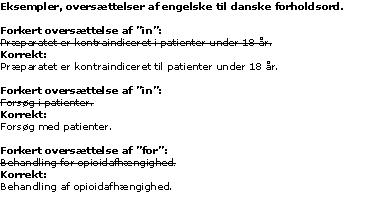Guidelines for translating medical product information
Central procedure
Three main rules and five topics
This page provides guidelines to translating medical product information from English to Danish. The three main rules, I. Write in Danish, II. Write clearly, III. Write to the reader trace through the five topics below. In the factbox to the right you can find an "Overview of grammatical terms and abbreviations" and other documents that elaborate on the specific tips.
Each topic is subdivided alphabetically, leaving out letters without a tip. For example, if no tips begin with the letter A, the letter A does not appear.
3 Main rules
I. Write in Danish
The Danish and English languages have many differences from a linguistic point of view. Therefore, the process of translating involves constant rephrasing and adaptation. The translation task is a process of transforming meaning, linguistic usage and language structure from one language to another. Translating does not equal copying a text word by word from one language to another. Here is an example of an unfortunate translation:
"Copenhagen Airport: We take your bags and send them in all directions".
II. Write clearly
You should avoid sentence structures that are unnecessarily complex. Language should never stand in the way of the message. Neither technical documents nor instructions for non-specialists become easier to read if the language is complex and lengthy like the example below:
"Samspilssituationer, involverende spæde eller yngre personer, engageret i diverse uspecificerede rekreative sysler frembringer almindeligvis de mest hensigtsmæssige resultater, såfremt participanterne er indbyrdes kompatible.
(Written in a different way: "lige børn leger bedst")".
III. Write to the reader
Each type of product information has its own target group. While the target group of the product summaries consists of healthcare professionals, certain types of labelling and all patient information leaflets should be readable to non-professionals. The choice of words should reflect whether you are writing to professionals or non-professionals.
5 topics
- Spelling
- Linguistic style
- Linguistic differences between English and Danish
- Tips applicable to product summaries in particular
- Tips applicable to patient information leaflets in particular
1. Spelling
Here is a selection of the rules of orthography that can pose problems.
Adverbs
Be aware of the difference between adverbs and adjectives.
Joining of nouns
Compound nouns are very different from English to Danish. In English, the nouns are not joined into one word even though they belong together. Therefore, you often see sentences with chains of up to three or four nouns after each other in English texts. That way of making compound words cannot be transferred to Danish, where compounds with loss of stress are written in one word . Having said that, complex compounds consisting of three or even more words and unusual compounds most often become unreadable if you join them into one word in the Danish translation. Therefore, if you are faced with a complex compound, you can either put a hyphen between the words or change the compound entirely.
You can find further information in the factbox on the right side of this page:
- "Joining of nouns"
- "Loss of stress", an explanation of the concept.
Example, hyphenated compounds (1 and 2: first unit consists of a word and a number, 3: the compound already contains a hyphen, 4: first unit is written in two words).
- type 2-diabetes
- fase II- og III-undersøgelser
- type 2-diabetes-patienter
- in vivo-aktivitet.
Prepositional phrases
"Uden for" or "udenfor"? - Check whether the preposition is positioned before a noun.
One word - as an adverb, without a subsequent noun:
Den normale koncentration er 0,5 mg/ml. Den aktuelle koncentration lå udenfor.
Punctuation
The Danish Medicines Agency recommends using the grammatical comma, as many sentences in the product summaries contain a lot of information and several insertions. The grammatical comma is inserted by finding subjects and sentence verbs. You insert a comma between each pair of subject and a sentence verb. This makes it easy to identify the subordinate clause, and in this way the whole sentence is divided into clearer units.
Example
2. Linguistic style
Product information should be written in a way that makes it easy to read. Complex or linguistic structures unfamiliar to the reader disturb the reading process. As a result, it will take the reader even longer to understand already difficult information. The linguistic style tips are intended to ensure that the reader does not have to spend a lot of time understanding what the language is supposed to communicate: the actual content.
Sentence structure, adverbials
Sentence a dverbials can be found by asking "how", "why" and "when". In the sentence "Lægemidlet skal tages to gange dagligt", "to gange dagligt" is the adverbial. It is good practice to avoid putting too many and too complex adverbials in front of the sentence verb and the subject of the main clause (in the front of the sentence). On the other hand, it is not always a good idea to put adverbials at the end of the sentence. If the distance between the adverbial and the statement that the adverbial modifies becomes too long, the meaning may become unclear. In those cases, it is a good idea to move the adverbial to the left, i.e. forward in the sentence.
You can find further information in the fact box on the right side of this page, under "Adverbials".
The meaning is not clear. Which statement does a3 moderate?
- Is there a risk of adverse reactions two weeks after the beginning of the treatment?
- Should the dosage be titrated gradually two weeks after the beginning of the treatment?
The meaning becomes clear when a3 is moved forward in the sentence and is placed right next to the subject and sentence verb of the main sentence.
Sentence structure, adverbials, accentuation
You can choose to accentuate the adverbial by moving it forward in the sentence.
Sentence structure, length
Write short sentences. Even though the English text contains long sentences, this does not have to be the case in the Danish text. Long, complex sentences are difficult to read - for professionals and non-professionals alike. Add some full stops and make sentences with insertions shorter.
You can find further information in the fact box on the right side of this page, under "Shortened and rephrased sentence" . Here, you will find another example of how the sentence below can be made even clearer with a few simple changes.
Sentence structure, nouns formed from verbs (gerunds/verbal nouns)
Use verbal nouns sparsely. Verbal nouns make the linguistic style unnecessarily complex. Change the noun to verbs in the infinitive form.
3 . Linguistic differences between English and Danish
Below, you will find an alphabetic list of some of the differences you should be aware of when translating a text from English to Danish.
Genitive
In English, it is common practice to express the genitive with the preposition "of". In Danish, we often express the genitive by putting an "s" at the end of the word. It is not downright incorrect to express the genitive by using "of" (af) in the Danish translation - but you should not do it too often. Be particularly careful with product names.
Noun forms, subject in the indefinite form
When introducing a new phenomenon or a new object in English, you often use the indefinite form of the noun. You should be careful with that in Danish, where you usually use the provisional subject "der" (you should not write: "En stol står i værelset", but: "Der står en stol i værelset"). If you leave out the provisional subject, the language is given a "telegram-like" and incomplete tone that can disturb the reading. At the other hand, the expression becomes stronger, because the subject is not hidden at the back of the sentence. The noun - and thereby the subject of the entire sentence - leaps to the eye when browsing through the text. Leaving out the provisional subject should be considered carefully - for example, if you want to emphasise something new or particularly important in the text.
Noun forms: indefinite to definite
Be aware of differences between English and Danish with regard to the use of definite and indefinite noun forms. In general, nouns should be in the definite form in Danish:
Eksempel patients = patienterne.
- When the noun "patienterne" (the patients) refers to a specific group of patients as opposed to the phenomenon "patients".
- When the noun includes all patients in a group as opposed to some of the patients.
In these two cases, you usually use the indefinite form "patients" in English. If the noun is not changed from indefinite form in English to definite form in Danish, the sentence may become misleading.
You can find further information in the fact box on the right side of this page, under "Noun forms: indefinite to definite".
Pitfalls
Recommend (anbefale)
You should translate "is not recommended" into "bør ikke anvendes" or the stricter "frarådes". Avoid the vague "anbefales ikke".
Prepositions
Avoid word-for-word translation from English and make sure that you use the correct Danish prepositions in the translation. Sometimes, there are several options (depending on meaning and context).
Sentence structure, incomplete sentences with forms of participle
Write complete sentences, i.e. sentences that contain a finite verb. In English, you often see incomplete sentences where the past or present participle stands alone without any auxiliary verb. This is not a normal sentence structure in Danish, and it may disturb the reading. At the same time, this sentence structure requires a noun in the indefinite form, which cannot easily be transferred to Danish (see the above section Noun forms: indefinite to definite).
4. Tips applicable to product summaries in particular
Experience shows that there are certain rules and tips that pose problems with regard to product summaries. The links below offer linguistic advice which is particularly important for translation of product summaries. The links are arranged according to category. The links are followed by the section Specifically for product summaries with more tips and explanations.
CATEGORY |
LINKS |
RULES: |
I. Write in Danish, II. Write clearly |
TOPICS |
|
Spelling: |
|
Linguistic style: |
Sentence structure, adverbials, Sentence structure, length, Sentence structure, incomplete sentences with forms of participle, |
Differences between English and Danish: |
Pitfalls, recommend (anbefale), Noun forms, subject in the indefinite form, Noun forms: indefinite to definite |
Specifically for product summaries
Terminology
Abbreviations
Translate unusual abbreviations into Danish
Example of abbreviations that should be translated into Danish.
QD |
= |
1 gang dagligt (once a day) |
BID |
= |
2 gange dagligt (twice a day) |
TID |
= |
3 gange dagligt (three times a day) |
QID |
= |
4 gange dagligt (four times a day) |
Pitfalls
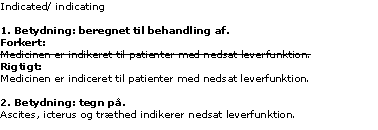
5. Tips applicable to patient information leaflets in particular
Experience shows that certain rules and tips are difficult to follow with regard to patient information leaflets. The links below offer linguistic advice which is particularly important to translation of patient information leaflets. The links are arranged according to category.
The links are followed by the section "Specifically for patient information leaflets" with more tips and explanations.
CATEGORY |
LINKS |
RULES: |
|
TOPICS |
|
Spelling: |
|
Linguistic style: |
Sentence structure, nouns formed from verbs (gerunds/verbal nouns), |
Differences between English and Danish: |
Pitfalls, recommend (anbefale), Noun forms, subject in the indefinite form |
Specifically for patient information leaflets
Pitfalls, tell (fortælle)
Sentence structure, use of active forms
Terminology, use of
Terminology, structure
Pitfalls
Tell (fortælle)
"Fortælle" is a transitive verb in Danish. This means that it requires a direct object: You tell someone something.
In Danish, you therefore have to insert "det" as a direct object if you choose to translate the English "tell" into "fortælle".
Differences in language usage
Be aware that "tell" and "fortælle" are not used in the same way in English and Danish. In Danish, "fortælle" often means "tell a story", i.e. communicating information that stretches over a longer course of events. However, you can use many other verbs in Danish when you want to express the meaning of giving a short message (examples: informal: "sige noget til nogen", formal: "informere nogen om noget", neutral: "give nogen besked om noget").
The Danish Medicines Agency recommends using "fortælle" in the patient information leaflets when patients need to inform the doctor of circumstances (such as pregnancy) which the doctor should take into account during the treatment process. In cases where the English "tell" encourages the patient to contact the doctor to get further information, we recommend using the expression "at tale med".
You can find further information in the fact box on the right side of this page, under "Transitive verbs ".

Terminology, use of
As far as possible, you should use layman expressions in cases where the reader cannot be expected to know the medical terms. Below you will find translations of medical terms into layman terms.
You can find further information in the fact box on the right side of this page by clicking on the link to the Commission-s "Multilingual Glossary of Technical and Popular Medical Terms".
Example, adaptation into patient-friendly language
Use størkne instead of koagulere when describing coagulation of blood.
Please note that it is far more common to use technical terms in texts for non-professionals in English than in Danish.
Examples, technical terms into layman terms.
anafylaksi - alvorlige allergiske reaktioner
antiviralt - virusdræbende
dyspnø - åndenød
glaukom - grøn stær
katarakt - grå stær
myokardieinfarkt - blodprop i hjertet
pneumoni - lungebetændelse.
Terminology, structure
If you cannot find a more common word for the medical term, write an explanation first followed by the technical term in brackets. It is important that you put the medical term at the end in brackets, as you may otherwise tire the reader.
Example, use of brackets:
Hvis du inden for relativt kort tid mærker tiltagende appetitløshed (anoreksi), føler dig svækket eller udmattet (astenisk) og taber i vægt, bør din læge overveje at foretage en generel medicinsk vurdering med særligt fokus på din leverfunktion.




